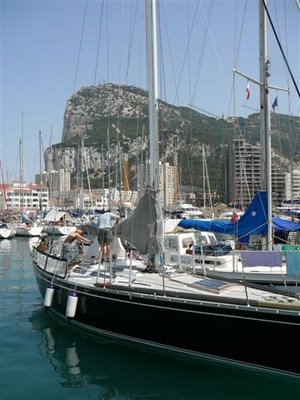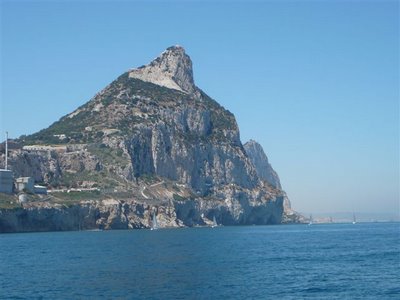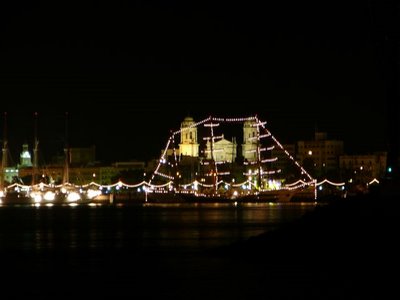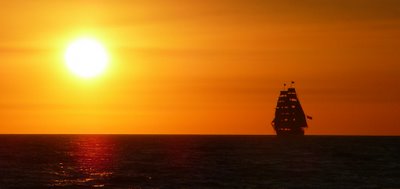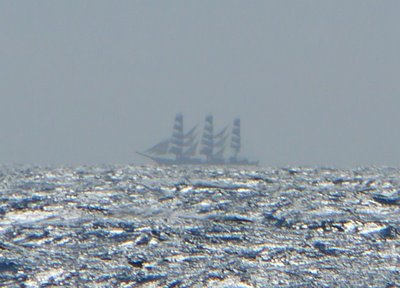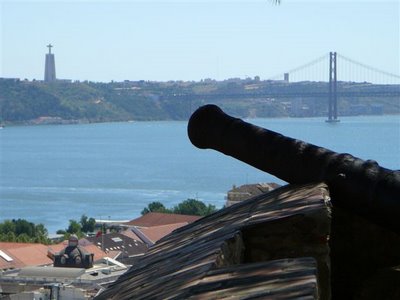
I’m in love. Or is it lust? Maybe just old fashioned desire. Anyhow I’ve been blown away by her lines and moves.
But enough about what it’s like sailing a Volvo 60 – you probably want to know something about Emma Richards. Sorry – Emma Sanderson, must get used to saying that.
Firstly, how did I wrangle it? The answer is it was one of the prizes of a charity auction – a day’s sailing with Emma Richards Sanderson. So as well as helping children in developing countries, as well as getting good karma for a year, I got a top day out.
It was simply fantastic – one of those 9/10 days. Alas it couldn’t be a 10/10 as I had a bad hair day. Now I know sailors are meant to be tough no nonsense and you can’t have any sense of vanity when having to rough it in a watch system for days on end with no shower or change of clothes all week.
But really – look at the picture below. That’s me on the wheel and for some reason my hair started corkscrewing in random directions like a crazy scientist whose latest invention has just gone bang. Of course Emma was very nice about it. But then she is – nice that is. You could imagine Pindar insisting on this contract terms for interviews:
Of course Emma was very nice about it. But then she is – nice that is. You could imagine Pindar insisting on this contract terms for interviews:
But this girl next door has sailed single handed around the world on an Open 60 with more sail area than this Volvo 60 and less mass – hence a greater power to weight ratio and without a crew or watch system (info point: on News International they used a rolling watch to keep the maximum hands on deck).
Here she is with the trimaran TietoEnator in the distance (making us the 2nd rather than 1st fastest boat on the water that day).
I asked her for helming tips as no less an authority as Tracy Edwards has praised her abilities. She told me how to avoid roll when sailing downwind with spinnaker up – steer under the sail. I knew that but pretended I didn’t.
She also explained why she got rid of the loo when racing in the Around Alone (now the Five Oceans). Apparently she was sitting there thinking (as one does) and imagined the weight of the pipes and the weight of the water in it, and working out that for every kilo of mass the boat must push out of its way many tonnes of water each day. And as she was racing it had to go and it was back to bucket and chuck-it.
This being a corporate charter boat there was of course more comforts. As you will see in the photo below the heads have a rather elegant loo paper roll.
 The heads also is well positioned to allow someone to prepare one meal while saying goodbye to the previous.
The heads also is well positioned to allow someone to prepare one meal while saying goodbye to the previous. Such an arrangement might be useful when sailing single handed or indeed in the highly competitive Volvo, but I was rather relieved to discover that lunch was sandwiches prepared on shore.
Such an arrangement might be useful when sailing single handed or indeed in the highly competitive Volvo, but I was rather relieved to discover that lunch was sandwiches prepared on shore.I mustn’t forget the rest of the crew – skipper was Loz Marriott who was in charge of the Pindar entry in the last Global Challenge, and he was joined by Spike and Ollie. Spike had crewed on Loz’s boat so there were three circumnavigators on board (and yes he got his name from his work with spinnakers – not, as I suggested, anything to do with Buffy the Vampire Slayer – a suggestion which must have lost me some of what little sailing cred I have).
It felt like there was a fourth – namely the presence of Emma’s other half Mike “Moose” Sanderson. The Sanderson’s are moving to NZ and during the day Emma was on the phone a couple of times to Mike making arrangements and there was a lot of talking about estate agents and packing boxes.
She also described life as part of the ABN1 team, and how Mike wins because on board he is a perfectionist. “He couldn’t do this” she said, meaning the gentle cruise where sails are not trimmed right.
I wonder if that really means I can do something Mike Sanderson can’t – something of a feat in sailing circles. But I doubt that.
What else did we talk of? Property, running, Porches, the Mid Sea race (which she is doing on Black Betty), Robin Knox-Johnston’s battle to be in time for the start of the 5 Oceans, New Zealand, time zones, living without sleep (the adrenalin keeps you going till crashing out when reach land), rounding Cape Horn – twice, watching albatrosses, solo vs. crewed, sailing the southern ocean, how long it takes to tack a Volvo 60, Mike’s ideas for the new Open 60 they are planning (which possibly could include a Vendee Globe) and his being courted for the next Volvo.
It was a perfect day for a sail. 15 – 20 knots of wind from the south, blue sky, gentle sea as we sailed from Gunwharf Quay out of Portsmouth Harbour, round the forts and then east past Cowes on up the Solent till between Yarmouth and Hurst Castle. All on board knew the waters well so could go from buoy to cardinal all the way without need for compass or GPS. However a difference from cruising those waters in a “normal” yacht was Pindar’s greater draught meant we had to be careful to follow the main channels.
We guests (three of us) did all the things a crew does on any boat: get in the fenders, coil the mooring lines, hoist the main on the coffee grinders (ok that bit might be different), trim the main sheet, then hoist and trim the jib. Of course our favourite bit was driving and we took it in turns at the wheel.
She is a dream to steer – light and responsive. I was lucky enough to take us through a tack and she turns effortlessly. In a few moments she was going over 10 knots, though we never powered up fully so the maximum was about 12.9 knots.
There were some differences with “normal” yachts. Some we didn’t explore – such as the water ballast system. Some we did – such as the way the main sail locks into position so that the strain is off the main halyard, reducing pressure on the mast. But overall it didn’t feel too unfamiliar.
But Pindar isn’t a normal yacht – she was News International and raced in the last but one Volvo. So this boat had been round the world and battled its way across the southern oceans and round both of the

All too soon it was time to head in for a beer and signing of log book (by Loz) and Emma’s book (well, by Emma).
It was a great, great, day.
If you want to get a feel of sailing Pindar, then just watch the video below.
I’d not just like but love to do it again – or even better on a Volvo 70 like Black Betty.
Better get saving for the next charity auction.
